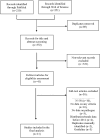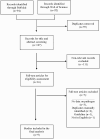Fusarium species,Scedosporium species, and Lomentospora prolificans: A systematic review to inform the World Health Organization priority list of fungal pathogens
- PMID: 38935914
- PMCID: PMC11210614
- DOI: 10.1093/mmy/myad128
Fusarium species,Scedosporium species, and Lomentospora prolificans: A systematic review to inform the World Health Organization priority list of fungal pathogens
Abstract
Recognizing the growing global burden of fungal infections, the World Health Organization established a process to develop a priority list of fungal pathogens (FPPL). In this systematic review, we aimed to evaluate the epidemiology and impact of infections caused by Fusarium spp., Scedosporium spp., and Lomentospora prolificans to inform the first FPPL. PubMed and Web of Sciences databases were searched to identify studies published between January 1, 2011 and February 23, 2021, reporting on mortality, complications and sequelae, antifungal susceptibility, preventability, annual incidence, and trends. Overall, 20, 11, and 9 articles were included for Fusarium spp., Scedosporium spp., and L. prolificans, respectively. Mortality rates were high in those with invasive fusariosis, scedosporiosis, and lomentosporiosis (42.9%-66.7%, 42.4%-46.9%, and 50.0%-71.4%, respectively). Antifungal susceptibility data, based on small isolate numbers, showed high minimum inhibitory concentrations (MIC)/minimum effective concentrations for most currently available antifungal agents. The median/mode MIC for itraconazole and isavuconazole were ≥16 mg/l for all three pathogens. Based on limited data, these fungi are emerging. Invasive fusariosis increased from 0.08 cases/100 000 admissions to 0.22 cases/100 000 admissions over the time periods of 2000-2009 and 2010-2015, respectively, and in lung transplant recipients, Scedosporium spp. and L. prolificans were only detected from 2014 onwards. Global surveillance to better delineate antifungal susceptibility, risk factors, sequelae, and outcomes is required.
Keywords: Fusarium; Lomentospora prolificans; Scedosporium apiospermum; antifungal resistance; epidemiology; fungemia; invasive fungal disease; mortality.
© The Author(s) 2023. Published by Oxford University Press on behalf of The International Society for Human and Animal Mycology.
Conflict of interest statement
This manuscript has been prepared in a personal capacity by the authors and reflects their views. The views expressed must not be attributed to the WHO, its Secretariat or its member states.
Dr. David Denning and his family hold Founder shares in F2G Ltd., a University of Manchester spin-out antifungal discovery company. All the other authors have no conflicts of interest to declare.
Figures



References
-
- Vazirani J, Westall GP, Snell GI, Morrissey CO. Scedosporium apiospermum and Lomentospora prolificans in lung transplant patients—a single center experience over 24 years. Transpl Infect Dis. 2021; 23: e13546. - PubMed
-
- Anaissie EJ, Kuchar RT, Rex JH, et al. Fusariosis associated with pathogenic Fusarium species colonization of a hospital water system: a new paradigm for the epidemiology of opportunistic mold infections. Clin Infect Dis. 2001; 33: 1871–1878. - PubMed
-
- Guarro J. Fusariosis, a complex infection caused by a high diversity of fungal species refractory to treatment. Eur J Clin Microbiol Infect Dis. 2013; 32: 1491–1500. - PubMed
-
- Tortorano AM, Prigitano A, Esposto MC, et al. European confederation of medical mycology (ECMM) epidemiological survey on invasive infections due to Fusarium species in Europe. Eur J Clin Microbiol Infect Dis. 2014; 33: 1623–1630. - PubMed
Publication types
MeSH terms
Substances
Supplementary concepts
Grants and funding
LinkOut - more resources
Full Text Sources
Miscellaneous

